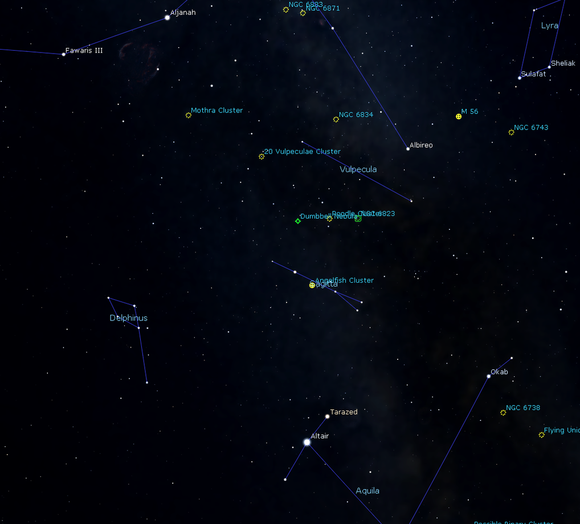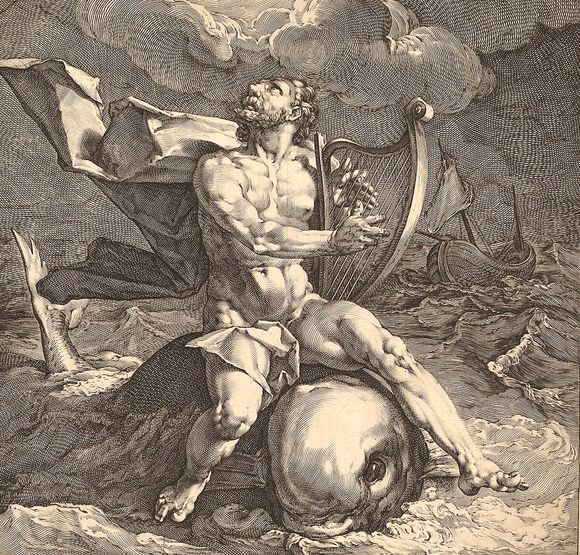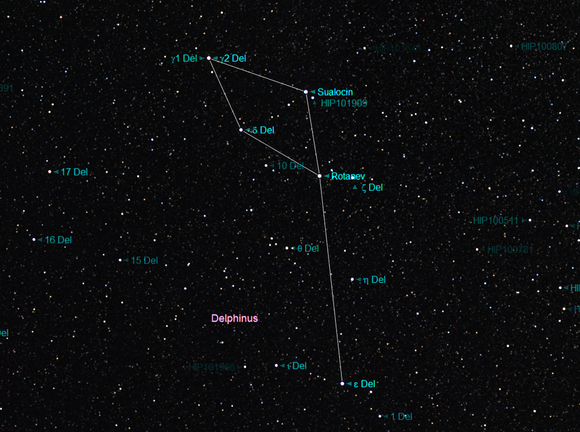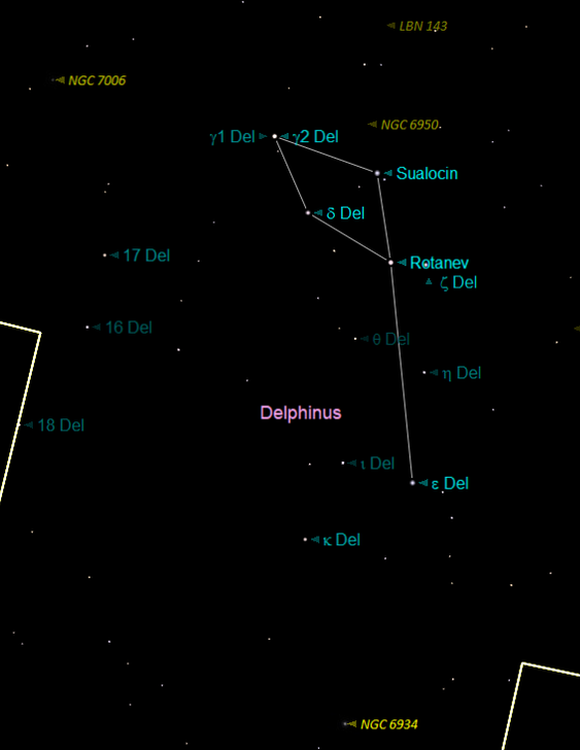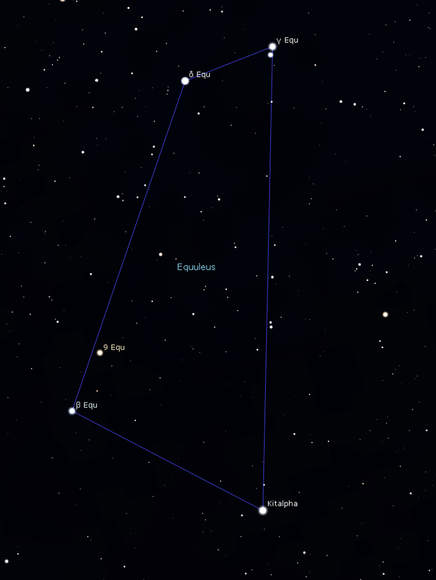Delphinus the Dolphin is a small constellation residing just outside the confines of the summer triangle to the east of a line joining Altair to Deneb. It sits close to the celestial equator. Delphinus is one of the original 48 constellations listed by the 2nd century astronomer Ptolemy, and remains one of the 88 modern constellations recognized by the IAU. Ranked 69th in size, it's 'brightest' stars form a distinctive diamond-shaped asterism symbolizing a dolphin, but also known as Job's Coffin. It is bordered (clockwise from North) by Vulpecula, Sagitta, Aquila, Aquarius, Equuleus and Pegasus.
In mythology Delphinus is associated with two tales. In one, the dolphin represents a messenger of the sea god Poseidon, sent to seek out the nymph Amphitrite, one of the Nerieds, who resisted the gods advances. The dolphin found the nymph, soothed her and brought her back to the god. The two were later married. Poseidon decided to honour the dolphin by placing him among the stars.
In the other myth, it was Apollo, the god of poetry and music, who honoured the dolphin with a place in the sky for saving the life of Arion, a poet and musician, whose skill with the lyre made him famous. Arion was sailing back to Greece after a successful concert tour of southern Italy when the sailors mutinied, stole the money Arion had made and threatened to throw him overboard. Arion asked them to let him sing one last song and his music drew several dolphins to the ship. Arion jumped overboard whereupon one of the dolphins saved him and carried him all the way back to Greece. In this version of the myth, Apollo placed the dolphin next to the constellation of Lyra, which represents Arion’s lyre.
Jan Muller after Cornelis van Haarlem Arion on a Dolphin, c. 1590, National Gallery of Art
(click for larger image)
The constellation Delphinus was also sometimes referred to as Job’s Coffin because of its long, box-like shape. Mostly, the name was restricted to the asterism formed by Alpha, Beta, Gamma and Delta Delphini.
Delphinus is a faint constellation with only two stars brighter than 4th magnitude, Beta Delphini (Rotanev) at magnitude 3.6 and Alpha Delphini with a magnitude of 3.8. Delphinus contains five named stars; Aldulfin (Epsilon Delphini), Musica (18 Delphini), Rotanev (Beta Delphini A), Shama (HAT-P-23), and Sualocin (Alpha Delphini Aa).
- Beta Delphini - Rotanev is the brightest star in Delphinus at magnitude +3.6. The star’s name was given by the Italian astronomer Niccolò Cacciatore (1770 – 1841). The Latinized version of this is Nicolaus Venator, which spelled backwards are the names of alpha and beta delphini. Beta Delphini is a binary star system consisting of a pair of white stars of spectral types F5 III and F5 IV, a giant and a sub giant. They orbit each other with a period of 26 years. They are separated by only 0.44 arc seconds, which makes them difficult to resolve in a telescope. The system lies just over 100 light years from Earth
- Alpha Delphini - Saulocin is the second brightest star in the constellation with a magnitude of +3.75. It is a multiple star system consisting of at least 7 members. The brightest two, designated Alpha Delphini A, and Alpha Delphini Ab, form a spectroscopic binary star, separated by only 0.2 arc seconds and only resolved interferometrically. They orbit each other with a period of 17 years. Alpha Delphini Aa is a blue-white sub giant star of 2.82 solar masses and a radius 3.92 times that of the Sun. Alpha Delphini Ab is not unerstood as well as it is too close to the brighter primary. Five other stars, designated Alpha Delphini B, C, D, E, and F, are likely optical companions
- Epsilon Delphini -Aldulfin (dolphins tail) is a blue-white giant of the spectral type B6. It has a visual magnitude of 4.03 and lies at distance of 330 light years. It is a suspected of being slightly variable. The star is 4.6 times larger than the Sun and about 676 times more luminous.
- Gamma Delphini is a binary star system composed of a white spectral type F7V main sequence star and an orange sub giant. The system lies at a distance of 101 light years from Earth. The stars have apparent magnitudes of 5.14 and 4.27. The components are separated by 10.22 arc seconds and orbit each other with a period of 3,249 years.
- Delta Delphini is a spectroscopic binary star with a combined apparent magnitude of 4.43. It lies at a distance of 223 light years from the Sun. The two components orbit each other with a period of 40 days. Both stars are classified as Delta Scuti variables, young pulsating stars whose brightness varies as they expand and contract as they come to the end of main sequence lifetimes.
- Rho Aquilae is a white main sequence dwarf of the spectral type A2V. The star is 19.5 times more luminous than the Sun. It has an apparent magnitude of 4.94 and lies at an approximate distance of 150 light years from Earth. Its estimated age is between 50 and 120 million years. Whoa, whoa, whoa, why Aquilae when it is in Delphinus? Well until 1992 it belonged to the constellation Aquila, but subsequently has moved over the border into Delphinus.
- Musica (18 Delphini) is a yellow giant star with a mass 2.3 times that of the Sun and a radius 8.5 times solar. The star has an apparent magnitude of 5.5 and resides 250 light years away. It is 40 times more luminous than the Sun. 18 Delphini has a confirmed exo-planet in its orbit discovered in 2008. The planet is over 10 times more massive than Jupiter and orbits the star from a distance of 2.6 astronomical units with a period of about 993 days.
- Shama is beyond naked eye limits with an apparent mag of 9.1. It is an orange main sequence star of the spectral type K0V and lies at a distance of about 160 light years. The star is however not dissimilar in size and mass to our Sun, being only slightly less massive and luminous. It is estimated to be 7.2 billion years old. In 2006 a planet was confirmed to be orbiting Shama roughly half the mass of Jupiter from a distance of 1.105 astronomical units with a period of 439.3 days.
Deep sky Objects
Delphinus contains no Messier objetcs, but is not void of deep sky interest,
- NGC 6934 (caldwell 72) is a relatively large globular cluster near the star Epsilon Delphini. It is approximately 52,000 light years distant and has a visual magnitude of 8.83 and is some 8.4′ in diameter. The cluster was discovered by William Herschel in 1785.
- NGC 7006 (Caldwell 42) is a globular star cluster located approximately 137,000 light years away in the outskirts of the Milky Way. The cluster is part of the galactic halo. NGC 7006 has a visual magnitude of 10.6 and is some 2.8′ in size. It appears close to the star Gamma Delphini.
- NGC 6891 is a small planetary nebula located near the star Rho Aquilae. It has an apparent size of 0.33′ by 0.3′. The nebula is approx 7,200 light years distant from Earth.
- NGC 6905 is another small planetary nebula, bluish in colour. It can be observed in a six-inch (150mm) telescope. It has an apparent magnitude of 10.9 and lies 7,500 light years away. It was discovered by William Herschel in 1784
Equuleus - the little foal or horse
Equuleus is the second smallest constellation in the night sky, after Crux-the Southern Cross, occupying only 72 square degrees. It contains no stars brighter than fourth magnitude. The neighbouring constellations are Aquarius, Delphinus and Pegasus. The origin of the constellation is unknown, but Equuleus was introduced by the Greek astronomer Claudius Ptolemy in the 2nd century. Equuleus does not have any stars brighter than magnitude +3 or, contain any within 10 parsecs (32.6 light years) of Earth.
In mythology Equuleus is usually associated with Hippe, the daughter of the centaur Chiron in Greek mythology. She was seduced by Aeolus and became pregnant with his child. Ashamed to tell her father, she hid the pregnancy from Chiron and escaped to the mountains and stayed there until she gave birth to the child, named Melanippe. When Chiron came looking for Hippe, she prayed to the gods who turned her into a mare and placed her amongst the constellations.
- The brightest star in the constellation is Kitalpha, Alpha Equulei, (meaning a piece of the horse) with an apparent magnitude of 3.9. It is a spectroscopic binary star composed of a yellow giant of the spectral type G7 and a chemical peculiar white main sequence star. The primary component has a mass 2.3 times that of the Sun and a radius 9.2 times greater. It is 50 times more luminous than the Sun. The companion is hotter, smaller and slightly less massive, with a size of 2.6 solar radii and a mass of 2.0 solar masses. It shines with 26.3 solar luminosities. The star’s estimated age is 740 million years. The distance is less than 200 light years.
- Delta Equulei is the second brightest star in Equuleus. It is a binary system with a combined visual magnitude of 4.47, located at a distance of 59.4 light years. Both components have the stellar classification F7V, indicating white main sequence stars. The primary component is brighter, with an apparent magnitude of 5.19, while the companion shines at magnitude 5.52. Both stars are slightly larger and more massive than the Sun.
- Gamma Equulei is double star. It lies at a distance of 118 light years from Earth and has an apparent magnitude that varies from 4.58 to 4.77. The star’s spectrum corresponds to an A9 main sequence star, but is classified as a rapidly oscillating Ap (roAp) star, a chemically peculiar star.
- Beta Equulei is a white main sequence star of the spectral type A3V. The star has an apparent magnitude of 5.19 and lies approximately 133 light years away. It is 4 times larger than the Sun and 78 times more luminous. Its estimated age is 600 million years.
Equuleus has no deep sky objects of note accessible in normal amatuer scopes.
Credits - Sky Charts: Stellarium Software and Starry Night Pro Plus 8 unless otherwise stated.
- Log in to post comments

